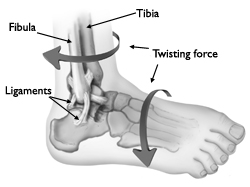Ankle Fractures In Children
Article by Dr. Darren R Keiser MD

A broken ankle, also called an ankle fracture, is a common childhood injury. An ankle fracture is a break in one or more of the bones that make up the ankle: the tibia, fibula, and talus.
Ankle fractures in children are more likely to involve the tibia and fibula (the long bones in the lower leg) than the talus (a smaller bone in the foot). Fractures at the ends of the tibia and fibula typically involve the growth plates. Growth plates are areas of developing cartilage tissue that regulate bone growth and help determine the length and shape of the adult bone.
Growth plate fractures in the ankle often require immediate attention because the long-term consequences may include legs that grow crooked or of unequal length.
An orthopedic surgeon will provide counseling about treatment options, as well as longer term follow-up care to monitor the outcome of the treatment.
Causes
Twisting Force
Pediatric ankle injuries typically occur during sports or vigorous play when a child’s lower leg or foot twists unexpectedly.
Sports involving lateral motion and jumping — like basketball — may put children at higher risk for ankle injuries. For example, when jumping to defend, shoot, or rebound, a child may land on another child’s foot, causing the foot to twist or roll to the inside or outside.
Growth Plates
The long bones of the body do not grow from the center outward. Instead, growth occurs at each end of the bone around the growth plate. When a child becomes full-grown, the growth plates harden into solid bone.
Because growth plates are the last portion of bones to harden, they are vulnerable to fracture. In fact, the ligaments that attach the tibia and fibula to the talus bone are generally stronger than the growth plates. This is why an ankle twist that would result in a sprain in an adult is more likely to cause a growth plate fracture in a child.
Pediatric ankle fractures account for 9% to 18% of all growth plate fractures. In children age 10 to 15 years, only injuries to the wrist and hand are more common than ankle fractures. These older children are more likely to participate in strenuous sports activities, and their growth plates are not yet fully mature.
**
Call the office of Dr. Darren Keiser to set up an appointment
 A broken ankle, also called an ankle fracture, is a common childhood injury. An ankle fracture is a break in one or more of the bones that make up the ankle: the tibia, fibula, and talus.
Ankle fractures in children are more likely to involve the tibia and fibula (the long bones in the lower leg) than the talus (a smaller bone in the foot). Fractures at the ends of the tibia and fibula typically involve the growth plates. Growth plates are areas of developing cartilage tissue that regulate bone growth and help determine the length and shape of the adult bone.
Growth plate fractures in the ankle often require immediate attention because the long-term consequences may include legs that grow crooked or of unequal length.
An orthopedic surgeon will provide counseling about treatment options, as well as longer term follow-up care to monitor the outcome of the treatment.
A broken ankle, also called an ankle fracture, is a common childhood injury. An ankle fracture is a break in one or more of the bones that make up the ankle: the tibia, fibula, and talus.
Ankle fractures in children are more likely to involve the tibia and fibula (the long bones in the lower leg) than the talus (a smaller bone in the foot). Fractures at the ends of the tibia and fibula typically involve the growth plates. Growth plates are areas of developing cartilage tissue that regulate bone growth and help determine the length and shape of the adult bone.
Growth plate fractures in the ankle often require immediate attention because the long-term consequences may include legs that grow crooked or of unequal length.
An orthopedic surgeon will provide counseling about treatment options, as well as longer term follow-up care to monitor the outcome of the treatment.

